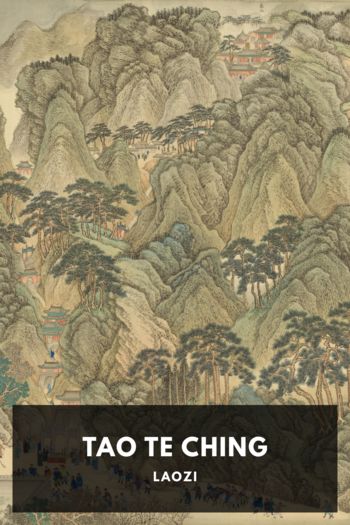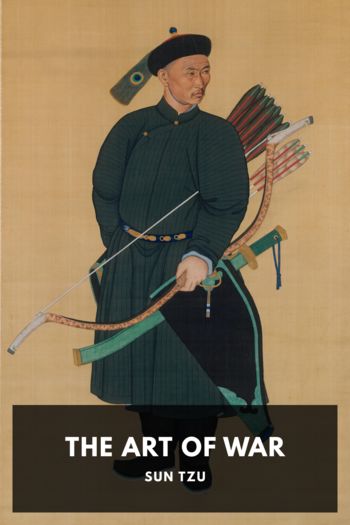Tao Te Ching by Laozi (reading comprehension books txt) 📕

- Author: Laozi
Book online «Tao Te Ching by Laozi (reading comprehension books txt) 📕». Author Laozi
In translating 果 by “striking a decisive blow,” I have, no doubt, followed Julien’s “frapper un coup décisif.” The same 果 occurs six times in par. 3, followed by 而, and Chiao Hung says that in all but the first instance the 而 should be taken as equivalent to 於, so that we should have to translate, “He is determined against being vain,” etc. But there is no necessity for such a construction of 而.
“Weakness” and not “strength” is the character of the Tao; hence the lesson in par. 4. ↩
偃武, “Stilling War.” The chapter continues the subject of the preceding. The imperially-appointed editors of Wang Pi’s Text and Commentary (1765) say that from the beginning of par. 2 to the end, there is the appearance of text and commentary being mixed together; but they make no alteration in the text as it is found in Ho-shang Kung, and in all other ancient copies.
The concluding sentence will suggest to some readers the words of the Duke of Wellington, that to gain a battle was the saddest thing next to losing it. ↩
聖德. Chalmers translates this by “sagely virtue.” But I cannot adopt that rendering, and find it difficult to supply a better. The “virtue” is evidently the attribute of the Tao come out from the condition of the absolute, and capable of being named. In the former state it has no name; in the latter, it has. Par. 1 and the commencement of par. 4 must both be explained from ch. 1.
The “primordial simplicity” in par. 2 is the Tao in its simplest conception, alone, and by itself, and the 始制 in par. 4 is that Tao come forth into operation and become Tê, the Tê which affords a law for men. From this to the end of the paragraph is very obscure. I have translated from the text of Wang Pi. The text of Ho-shang Kung is different, and he comments upon it as it stands, but to me it is inexplicable. ↩
辨德, “Discriminating between (different) Attributes.” The teaching of the chapter is that the possession of the Tao confers the various attributes which are here most distinguished. It has been objected to it that elsewhere the Tao is represented as associated with dullness and not intelligence, and with weakness and not with strength. But these seem to be qualities viewed from without, and acting on what is beyond itself. Inwardly, its qualities are the very opposite, and its action has the effect of enlightening what is dark, and overcoming what is strong.
More interesting are the predicates in par. 2. Chiao Hung gives the comment on it of the Indian monk, Kumārajīva, “one of the four suns of Buddhism,” and who went to China in AD 401: “To be alive and yet not alive may well be called long; to die and yet not be dead may well be called longevity.” He also gives the view of Lu Nung-shih (AD 1042–1102) that the freedom from change of Lieh-tzŭ, from the death of Chuang-tzŭ, and from extinction of the Buddhists, have all the same meaning as the concluding saying of Laozi here; that the human body is like the covering of the caterpillar or the skin of the snake; that we occupy it but for a passing sojourn. No doubt, Laozi believed in another life for the individual after the present. Many passages in Chuang-tzŭ indicate the same faith. ↩
任成, “The Task of Achievement.” The subject is the greatness of what the Tao, called here by Lao’s own name for it in ch. 25, does; and the unconscious simplicity with which it does it; and then the achievements of the sage who is permeated by the Tao. Par. 2 is descriptive of the influence of the Tao in the vegetable world. The statements and expressions are much akin to those in parts of chapters 2, 10, and 51, and for Ho-shang Kung’s difficult reading of 不名有 some copies give 而不居, as in chapter 2. ↩
仁德, “The Attribute of Benevolence.” But there seems little appropriateness in this title. The subject of the chapter is the inexhaustible efficacy of the Tao for the good of the world.
The Great Image (of the invisible Tao) is a name for the Tao in its operation; as in chapters 14 and 41. He who embodies this in his government will be a centre of attraction for all the world. Or the 天下住 may be taken as a predicate of the holder of the Great Image:—“If he go all under heaven teaching the Tao.” Both constructions are maintained by commentators of note. In par. 2 the attraction of the Tao is contrasted with that of ordinary pleasures and gratifications. ↩
微明, “Minimising the Light;” equivalent, as Wu Chʽêng has pointed out, to the 襲明 of ch. 27.
The gist of the chapter is to be sought in the second paragraph, where we have two instances of the action of the Tao by contraries, supposed always to be for good.
But there is a





Comments (0)